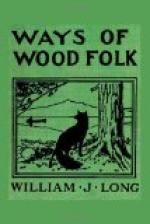There are few creatures in the wilderness more difficult to observe than the beavers, both on account of their extreme shyness and because they work only by night. The best way to get a glimpse of them at work is to make a break in their dam and pull the top from one of their houses some autumn afternoon, at the time of full moon. Just before twilight you must steal back and hide some distance from the dam. Even then the chances are against you, for the beavers are suspicious, keen of ear and nose, and generally refuse to show themselves till after the moon sets or you have gone away. You may have to break their dam half a dozen times, and freeze as often, before you see it repaired.
It is a most interesting sight when it comes at last, and well repays the watching. The water is pouring through a five-foot break in the dam; the roof of a house is in ruins. You have rubbed yourself all over with fir boughs, to destroy some of the scent in your clothes, and hidden yourself in the top of a fallen tree. The twilight goes; the moon wheels over the eastern spruces, flooding the river with silver light. Still no sign of life. You are beginning to think of another disappointment; to think your toes cannot stand the cold another minute without stamping, which would spoil everything, when a ripple shoots swiftly across the pool, and a big beaver comes out on the bank. He sits up a moment, looking, listening; then goes to the broken house and sits up again, looking it all over, estimating damages, making plans. There is a commotion in the water; three others join him—you are warm now.
Meanwhile three or four more are swimming about the dam, surveying the damage there. One dives to the bottom, but comes up in a moment to report all safe below. Another is tugging at a thick pole just below you. Slowly he tows it out in front, balances a moment and lets it go—good!—squarely across the break. Two others are cutting alders above; and here come the bushes floating down. Over at the damaged house two beavers are up on the walls, raising the rafters into place; a third appears to be laying on the outer covering and plastering it with mud. Now and then one sits up straight like a rabbit, listens, stretches his back to get the kinks out, then drops to his work again.
It is brighter now; moon and stars are glimmering in the pool. At the dam the sound of falling water grows faint as the break is rapidly closed. The houses loom larger. Over the dome of the one broken, the dark outline of a beaver passes triumphantly. Quick work that. You grow more interested; you stretch your neck to see—splash! A beaver gliding past has seen you. As he dives he gives the water a sharp blow with his broad tail, the danger signal of the beavers, and a startling one in the dead stillness. There is a sound as of a stick being plunged end first into the water; a few eddies go running about the pool, breaking up the moon’s reflection; then silence again, and the lap of ripples on the shore.




